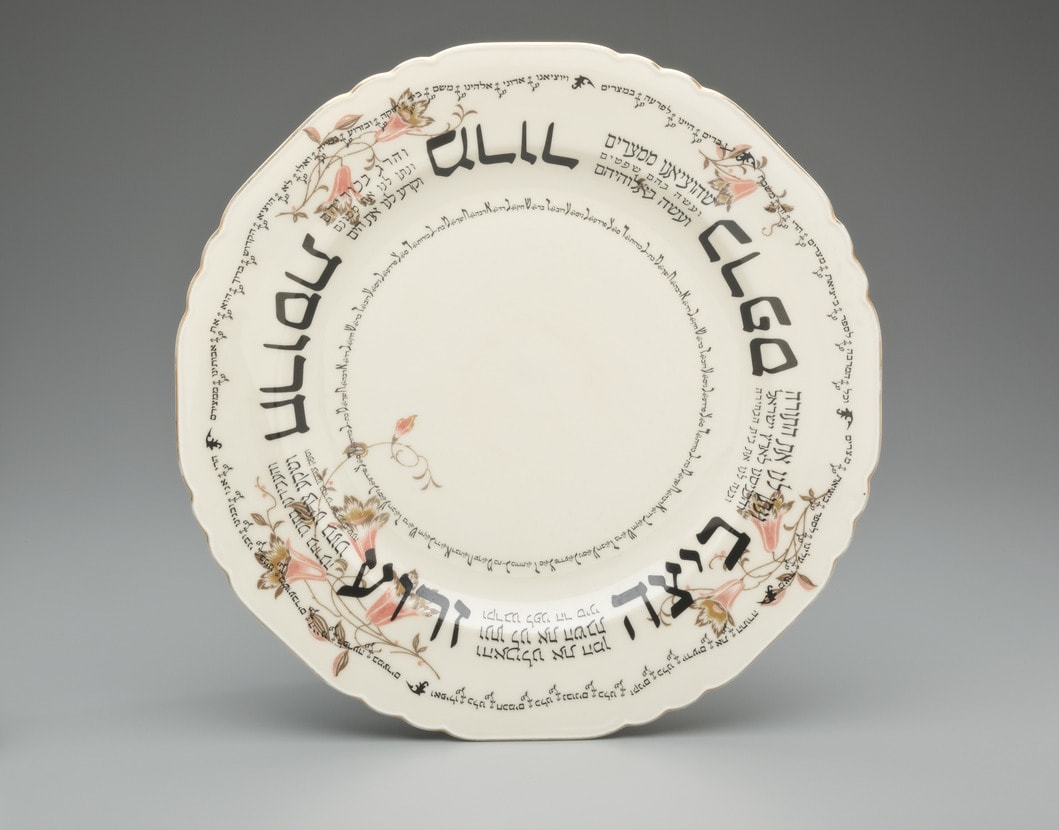
- Object Name:
- Seder Plate
- Artist/Maker:
- Johnathan Hopp
- Bio:
- Israeli, b. 1975
- Place Made:
- Jaffa, Israel
- Date:
- 2009
- Medium:
- Found plate: ceramic decal
- Dimensions:
- 1 5/16 × 11 13/16 in. (3.3 × 30 cm)
- Credit Line:
- Purchase: Contemporary Judaica Acquisitions Committee Fund
- Accession Number:
- 2010-20
Not On View
The Passover table bears a number of emblematic items: glasses of wine that are drunk at specified points in the evening as the Exodus story is retold; three pieces of matzah (unleavened bread); copies of the Haggadah for the participants; and, centrally, a plate bearing certain foods that celebrate freedom and recall the bitterness of slavery. These typically include greens or parsley, representing growth and fruition; a sweet paste of apples and nuts, symbolizing the mortar used by the Jewish slaves in Egypt; bitter herbs and salt water as reminders of the affliction of bondage; a lamb shank bone and roasted egg, referring to the rituals of the Temple in Jerusalem. The orange, a recent addition to the seder plate, symbolizes support of marginalized groups, specifically lesbian and gay communities.
The tradition of a special plate or basket for the seder foods originates in a reference in the Mishnah (first–second century CE), recording older customs, but there is no record of how it was decorated. In Europe in the sixteenth century, artisans began making seder plates with scenes from the Passover story, or of the table and its guests. In one tradition, the decoration establishes the order and placement of the symbolic foods. Some of these plates are explicitly intended to hold those foods; others may have had a more general Passover use.
Contemporary artists continue to reinterpret traditional Judaica objects such as the seder plate. The Israeli artists Johnathan Hopp and Sarah Auslander searched through the flea markets of Jaffa for used dinnerware. They repurposed the plates by sealing ceramic decals of the seder service over the original plate patterns, merging past with present.
The tradition of a special plate or basket for the seder foods originates in a reference in the Mishnah (first–second century CE), recording older customs, but there is no record of how it was decorated. In Europe in the sixteenth century, artisans began making seder plates with scenes from the Passover story, or of the table and its guests. In one tradition, the decoration establishes the order and placement of the symbolic foods. Some of these plates are explicitly intended to hold those foods; others may have had a more general Passover use.
Contemporary artists continue to reinterpret traditional Judaica objects such as the seder plate. The Israeli artists Johnathan Hopp and Sarah Auslander searched through the flea markets of Jaffa for used dinnerware. They repurposed the plates by sealing ceramic decals of the seder service over the original plate patterns, merging past with present.
Information may change as a result of ongoing research.